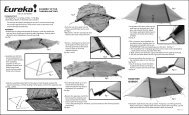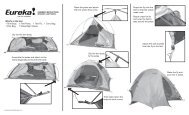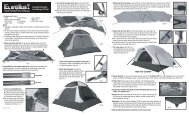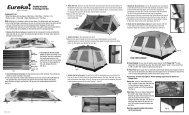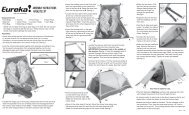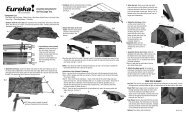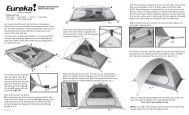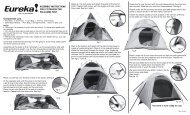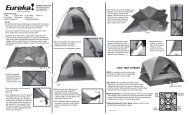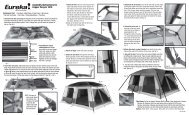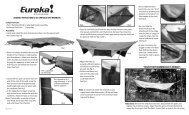ASSEMBLY INSTRUCTIONS FOR THE TITAN TENT: - Eureka Tent
ASSEMBLY INSTRUCTIONS FOR THE TITAN TENT: - Eureka Tent
ASSEMBLY INSTRUCTIONS FOR THE TITAN TENT: - Eureka Tent
Create successful ePaper yourself
Turn your PDF publications into a flip-book with our unique Google optimized e-Paper software.
<strong>ASSEMBLY</strong> <strong>INSTRUCTIONS</strong><br />
<strong>FOR</strong> <strong>THE</strong> <strong>TITAN</strong> <strong>TENT</strong>:<br />
Although it is possible to pitch this tent alone, it is faster and easier<br />
with two people. Do not drop tent bag or pole bag on its end. Do<br />
not bounce tent bag on its end to get the tent out. These actions<br />
may cut the shock cord and/or damage the pole ends.<br />
Component List: 1 <strong>Tent</strong> Body, 4 Poles, 1 <strong>Tent</strong> Fly,<br />
1 Fly Rod, 2 Brim Rods, 1 Pole Bag, 1 Carry Bag,<br />
1 Stake Bag w/ Stakes<br />
<strong>ASSEMBLY</strong><br />
1. Lay the tent body out on the ground and open the door. In windy<br />
conditions, the windward corner of the tent should be staked<br />
down. Take all of the poles and rods out of the carry bag,<br />
assemble them and divide according to their length.<br />
IMPORTANT: To prevent damage the spider hub and roof cloth<br />
are color coded. Orient the spider such that the roof fabric is not<br />
twisted and the two spider arms, colored yellow, face the tan<br />
fabric insert at the tent's peak.<br />
2. One end of each frame pole has a larger diameter. Insert this end<br />
onto one of the arms of the spider. Make sure that it seats<br />
securely. Improper fit can cause the spider to break. See fig.1.<br />
3. Follow the seam from the spider, down to the corner of the tent.<br />
Make sure that the spider is properly oriented, then insert the pin<br />
on the corner ring into the other end of the pole.<br />
fig. 1<br />
4. Insert the next pole onto the opposite arm on the spider. Tension<br />
this assembly by placing the corner pin in the other end of this<br />
pole. See fig.2.<br />
With the assembly on the ground, place a third pole into the spider<br />
and place the corner pin in the other end. Lift the spider and insert<br />
the last pole. Apply tension by inserting the corner pin into the end<br />
of this pole.<br />
5. Connect all clips and rings to the frame.<br />
See fig.3.<br />
fig. 3<br />
fig. 2<br />
Brim Rod<br />
Grommet<br />
6. Lay the fly out on the ground, upside down. Thread the brim rods<br />
through the sleeves on the fly. Fit the fly rod into the web pockets<br />
on the underside of the fly and secure with the Velcro tab at the<br />
center. See fig.4.<br />
7.Turn the fly right side up and<br />
drape it over the tent with a brim<br />
rod over each door. Wrap and<br />
secure the Velcro straps around<br />
the poles to keep the fly in place.<br />
Insert each end of a brim rod into<br />
the corresponding grommet on the<br />
tent. Set the hoods to the same<br />
height. If the fly has shifted, adjust<br />
the Velcro straps on the frame.<br />
Fasten the side release buckles at<br />
all of the corners and tension until<br />
wrinkles are gone.<br />
8. Stake out the tent through the corner rings. Stake opposite corners while<br />
applying tension to square the tent and remove wrinkles from the floor. Stake out<br />
the fly through the rings on the side of the fly. Stake down the side pull outs to<br />
provide maximum floor space. See fig.5.<br />
NOTES:<br />
• General purpose stakes have been included, sand or snow may require a more<br />
substantial stake. Purchase these from your <strong>Eureka</strong>! dealer.<br />
• When you roll down the windows, tuck the fabric into its pocket at the bottom.<br />
• The two corner closet/organizers are designed for clothes and small accessories.<br />
fig. 5<br />
fig. 4<br />
We recommend:<br />
During wind, the tent should be guyed out by the storm rings on the fly. Tie ropes<br />
(not included) to the rings and stake them out about three feet from the tent.<br />
See fig.5.<br />
When taking the tent down, reverse steps, leave door open and roll toward door<br />
to allow air to escape.<br />
To prevent condensation, keep the door and windows open. Open from the top in<br />
bad weather and from the bottom during fair weather.<br />
www.eurekatent.com<br />
1.800.572.8822<br />
REV E 4.09
WARNING:<br />
KEEP ALL FLAME AND HEAT SOURCES AWAY FROM THIS <strong>TENT</strong> FABRIC.<br />
• This tent meets the flammability requirements of CPAI-84. The fabric may<br />
burn if left in continuous contact with any flame source. The application of<br />
any foreign substance to the tent fabric may render the flame-resistant<br />
properties ineffective.<br />
• Do NOT operate any device which burns fuel inside your tent. Combustion<br />
consumes oxygen and can produce dangerous levels of carbon monoxide,<br />
which could lead to serious injury or death.<br />
SEAM SEALING:<br />
We recommend use of a sealer such as Kenyon Seam Sealer 3 or McNett Outdoor<br />
SeamGrip ®.<br />
• Work in a fully ventilated area.<br />
• Set the tent up or lay the tent out flat. Taut seams allow for even application and<br />
penetration of the sealer.<br />
• Decide which seams need to be sealed. For example, seams that will be exposed<br />
to rain, runoff, or ground level water are a must for sealing, while seams on<br />
uncoated nylon or mesh panels don’t need treatment. There is no need to seal<br />
the seams in the roof or the factory taped seams. We recommend sealing both<br />
floor and fly seams and reinforcements.<br />
• Apply sealant to the inside and outside of all exposed seams. Several thin layers<br />
will work better than one thick layer. Read and follow manufacture's instructions.<br />
STAKING:<br />
All tents need to be staked down to keep them from blowing away. Securing the<br />
tent by placing heavy objects inside is just not adequate.<br />
• Once the tent body is erected, stake it out before the fly is put on. This enables you<br />
to square the tent up to ensure that the fly goes on properly and that the seams<br />
align with the frame. Pull the base of the tent taut between each web stake out<br />
loop or ring & pin. Make sure that all corners are square. It is important that you<br />
don’t stake the tent out too tightly. You will know it’s too tight, if the door zippers<br />
can not be easily operated. Drive stakes through the web loops, or with ring & pin,<br />
drive the stake just outside the ring so that the “J” hook catches it. Tie a piece of<br />
cord or web into a loop through the ring to be used as a large stake loop if<br />
needed.<br />
• With the tent properly staked, drape the fly over the frame, attach its tent<br />
connection points and stake down any pull outs.<br />
• Do not attempt to remove the stakes by pulling on the tent becket loop, as this<br />
could cause the fabric to tear. The best way is to pry on the stake itself.<br />
Staking in special conditions:<br />
• Sand. Use long, broad stakes with plenty of surface area in loose soil.<br />
• Hard, Rocky, or Frozen Soil. Steel stakes work best. Store steel stakes<br />
separately. Their sharp edges can cut fabric and leave rust stains, which might<br />
damage your tent.<br />
• Snow. Use “dead man” anchors. Tie tent to buried objects (branches, tent bags, or<br />
stuff sacks filled with snow; or tie tents to snow shoes, skis, or ski poles, which are<br />
stuck in the snow.<br />
GUY LINES:<br />
Do not depend upon staking alone to keep your tent secure during high winds. Most<br />
tent models have built-in loops or rings at optimal guy out locations. It’s important<br />
to put in the extra time guying out your tent. Correctly done, it can save your tent<br />
during exceptional weather.<br />
• Make sure that the top fly is securely attached to the tent frame. Ties, hook and<br />
loop, or dog-bones and elastic loops are sewn to the underside of the fly for this<br />
purpose.<br />
• Attach parachute cord to the loops/rings and stake them in the ground three or<br />
four feet from the edge of the tent. If staked too close to the tent, wind can cause<br />
an upward pull that could dislodge the stakes.<br />
• If your tent does not have loops or rings for guy outs, attach guy lines 1/3 to<br />
1/2 of the way up the framework on the main sidewalls. This enables the<br />
guy line to support the lower section of the pole, while the upper pole can<br />
flex and deflect wind gusts. It is best to run two cords at an angle from the<br />
side of the guy out. This prevents all movement, except toward the anchor.<br />
The guy lines will work together through opposition. See illustrations below:<br />
Good:<br />
4 stakes /4 lines<br />
Best:<br />
4 stakes /8 lines<br />
CONDENSATION & VENTING:<br />
Through perspiration and breathing, an adult gives off about a pint of water<br />
overnight. If it cannot escape, the water vapor condenses to liquid. Most<br />
often, water found in the tent is a result of this condensation rather than<br />
from the tent leaking. Condensation often forms where the sleeping bag<br />
touches the side of the tent, under the sleeping pad, or on coated surfaces<br />
such as the door flaps. A tent’s double wall construction allows the vapor to<br />
escape through the roof to the outside, keeping the inside of the tent dry.<br />
Leave the windows partially open at night to provide cross ventilation and<br />
further reduce condensation. Cross ventilation becomes more important in<br />
very humid or extremely cold conditions when the permeable roof is less<br />
effective. The features that enhance ventilation are windows, short-sheeted<br />
flys (bottom venting), roof vents, and High/Low venting doors. These are<br />
specific to each tent model.<br />
Given the importance of proper ventilation, We use High/Low venting in most<br />
of our tents. This allows cooler air in through the low vents and warmer,<br />
moist air up and out through the high vents. High/Low venting is<br />
accomplished within the inner tent via roof vents, doors and windows. It is<br />
important to vent the vestibule. Unvented, it can inhibit airflow into the tent.<br />
Our tent vestibules profit from the ability to “short sheet” by means of<br />
zippers & toggles and staked vestibule pull outs create a bellowing effect.<br />
Most of our tents are equipped with a High/Low venting door. This design<br />
allows increased airflow into the tent from the bottom. Open the low<br />
vent/window to admit cool air, allowing the warmer air out through the<br />
high roof vents. When rain and wind prevent the low vent from being<br />
opened, the high door vent can still be used. Fly overhangs or vestibules<br />
protect it.<br />
ULTRAVIOLET LIGHT:<br />
Ultraviolet light damage to tent fabric is caused by excessive exposure to<br />
sunlight. While our fabrics are UV resistant, any synthetic fabric is<br />
susceptible to UV degradation. UV damage will cause nylon and polyester<br />
to become brittle and tear easily. We recommend that you use the rain fly<br />
even on clear days. It acts as a sunscreen to the tent. A rain fly is both easier<br />
and less expensive to replace if damaged. UV damage can be minimized by<br />
erecting tents on shaded sites with low exposure to direct sunlight.<br />
GENERAL POLE CARE:<br />
• Never let tent poles snap together as this can damage the pole end.<br />
• Do not drop tent or pole bags on their ends and do not bounce a tent bag<br />
on its end to get the tent out. These actions may cut the shock cord and<br />
damage the pole ends.<br />
• The aluminum frame may bend slightly and take a “set” through usage; this<br />
normally does not affect the performance of the frame.<br />
GENERAL <strong>TENT</strong> CARE:<br />
• Sweep the tent floor daily to prevent damage from stones.<br />
• Try not to wear shoes inside your tent.<br />
• Use a ground cloth whenever possible.<br />
• Do not keep food inside a tent. Hungry critters will chew through tent fabric in<br />
search of food.<br />
STORAGE:<br />
• Make sure the tent is completely dry, then store loosely rolled, in a dry, cool<br />
place. To prevent dust from collecting on the tent, cover it with a cloth. This<br />
allows the nylon/polyester fabric to breathe.<br />
• Ideally, the tent poles should be stored in their fully assembled state. This<br />
reduces the tension on the shock cord, prolonging its life.<br />
• The tent bag should be used only as a carry sack and not for storage.<br />
COLOR TRANSFER:<br />
• Do to the nature of tent fabrics, color can transfer from darker to lighter<br />
fabrics when the two fabrics are in contact over time when wet, damp or<br />
exposed to the combination of moisture and high heat. This does not effect<br />
the tent's performance. To prevent / minimize color transfer, always make<br />
sure your tent is completely dry prior to packing and storage.<br />
CLEANING:<br />
• Clean the tent by setting it up and wiping it down with a mild soap (liquid<br />
hand soap) and lukewarm water solution. Rinse thoroughly and dry<br />
completely. Never use detergent, washing machines or dryers because they<br />
can damage the tent’s protective coating and seams. After cleaning, be sure<br />
the tent is completely dry, especially the heavier, double-stitched areas such<br />
as the seams, before storing or mold / mildew are likely to grow.<br />
• Clean the tent poles with a cloth and lubricate them with silicone spray. This is<br />
especially necessary after ocean side camping to remove salt spray so the<br />
poles don’t corrode or stay gritty.<br />
• Clean the zippers with a quick dip in water and then dry them off. This is<br />
especially important if you’ve been camping in a location with sand/dirt. If<br />
you don’t clean the zippers, the sliders will wear out and eventually the teeth<br />
will become inoperable.<br />
ALTERATIONS OR MODIFICATIONS:<br />
DO NOT misuse, modify or alter this product in any way from its condition at<br />
the time of sale. Alteration, modification or any use of this product contrary<br />
to the accompanying written instructions shall void the warranty. Moreover,<br />
any misuse, alteration or modification of the product shall absolve Johnson<br />
Outdoors Gear LLC of any liability for property damages or injuries sustained<br />
as a result of such misuse, modification or alteration.<br />
LIMITED WARRANTY:<br />
What Is Covered: Johnson Outdoors Gear LLC warrants to the original<br />
purchaser that its products are free from defects in material and workmanship,<br />
for the life of the product, except as qualified below. The life of the product is<br />
determined from the date of purchase until such time as the product is no longer<br />
serviceable due to normal wear and tear.<br />
What Is Not Covered: Johnson Outdoors Gear LLC shall not be responsible for the<br />
natural breakdown of materials that occurs inevitably with extended use (e.g., Ultra<br />
Violet (UV) light damage on tents, exhausted zippers), or defects caused by accident,<br />
abuse, alteration, animal attack, storm damage, misuse or improper care.<br />
<strong>THE</strong>RE ARE NO O<strong>THE</strong>R EXPRESS WARRANTIES BEYOND <strong>THE</strong> TERMS OF THIS<br />
LIMITED WARRANTY. IN NO EVENT SHALL JOHNSON OUTDOORS GEAR LLC BE<br />
LIABLE <strong>FOR</strong> INCIDENTAL OR CONSEQUENTIAL DAMAGES.<br />
Some states do not allow the exclusion or limitation of incidental or consequential<br />
damages, so the above limitation or exclusion may not apply to you.<br />
What Johnson Outdoors Gear LLC Will Do: If after inspection we find that a<br />
product failed due to a manufacturing or material defect, we will repair or<br />
replace the product, at our option, without charge.<br />
How to Obtain Warranty Service: Return the product, freight prepaid, to the<br />
Dealer from whom it was purchased; or, contact our Customer Satisfaction<br />
Department for return authorization: toll free 1-800-572-8822. Collect<br />
shipments or shipments without return authorization cannot be accepted. The<br />
product registration card packaged with our product need not be returned for<br />
the warranty to be effective and for you to receive warranty service.<br />
Repairs: If your Johnson Outdoors Gear LLC product needs service or repair<br />
due to normal wear and tear, animal attack, accident or some other reason<br />
that is not covered under the warranty we will provide the necessary service<br />
for a reasonable charge, plus shipping and handling. We require that products<br />
accepted for any repair be properly cleaned according to our recommended<br />
care instructions. Please send your product or component that requires repair<br />
(e.g., tent fly), postage prepaid, along with a description of what needs<br />
attention. For service and repairs, please contact our Customer Satisfaction<br />
Department: toll free 1-800-572-8822<br />
How State Law Relates To This Warranty: This warranty gives you specific<br />
legal rights, and you may have other rights that vary from state to state.<br />
JOHNSON OUTDOORS GEAR LLC<br />
Our experience building quality<br />
outdoor equipment goes back over 100<br />
years! Today, we manufacture sleeping<br />
bags, screen houses, day-use<br />
shelters and camping tents. We also<br />
design and manufacture tents for the<br />
United States Military and for the<br />
rental industry.<br />
See eurekatents.com<br />
From baseplate and digital<br />
compasses to electronic<br />
instruments, our sister brands, Silva<br />
and Tech4o, put outdoor technology at<br />
your fingertips.<br />
See tech4o.com and silvausa.com<br />
Our brands are part of the Johnson<br />
Outdoors family of products. Visit all<br />
the brands at johnsonoutdoors.com<br />
We support the "Leave No Trace"<br />
Seven Principles:<br />
1. PLAN AHEAD AND PREPARE<br />
2. TRAVEL & CAMP ON DURABLE SURFACES<br />
3. DISPOSE OF WASTE PROPERLY<br />
4. LEAVE WHAT YOU FIND<br />
5. MINIMIZE CAMPFIRE IMPACTS<br />
6. RESPECT WILDLIFE<br />
7 . BE COURTEOUS OF O<strong>THE</strong>R VISITORS<br />
REV E. FEB 09



